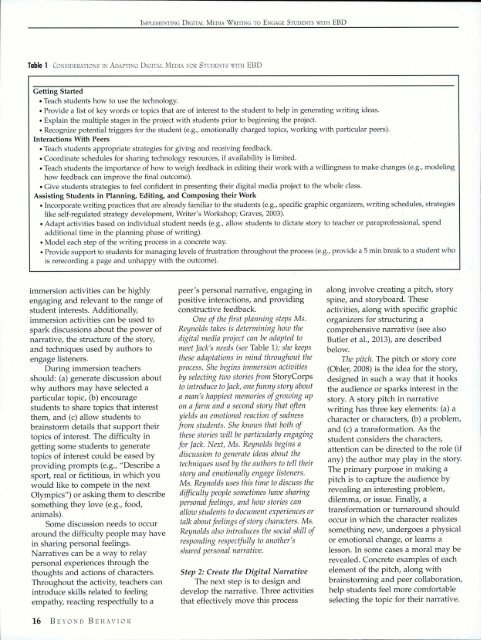Implementing Digital Media Writing to Engage Students With Emotional and Behavioral Disorders
You also want an ePaper? Increase the reach of your titles
YUMPU automatically turns print PDFs into web optimized ePapers that Google loves.
<strong>Implementing</strong> D igital M edia W riting <strong>to</strong> <strong>Engage</strong> <strong>Students</strong> with EBD<br />
Table 1 Considerations in Adapting <strong>Digital</strong> M edia for <strong>Students</strong> with EBD<br />
Getting Started<br />
• Teach students how <strong>to</strong> use the technology.<br />
• Provide a list of key words or <strong>to</strong>pics that are of interest <strong>to</strong> the student <strong>to</strong> help in generating writing ideas.<br />
• Explain the multiple stages in the project with students prior <strong>to</strong> beginning the project.<br />
• Recognize potential triggers for the student (e.g., emotionally charged <strong>to</strong>pics, working with particular peers).<br />
Interactions <strong>With</strong> Peers<br />
• Teach students appropriate strategies for giving <strong>and</strong> receiving feedback.<br />
• Coordinate schedules for sharing technology resources, if availability is limited.<br />
• Teach students the importance of how <strong>to</strong> weigh feedback in editing their work with a willingness <strong>to</strong> make changes (e.g., modeling<br />
how feedback can improve the final outcome).<br />
• Give students strategies <strong>to</strong> feel confident in presenting their digital media project <strong>to</strong> the whole class.<br />
Assisting <strong>Students</strong> in Planning, Editing, <strong>and</strong> Composing their Work<br />
• Incorporate writing practices that are already familiar <strong>to</strong> the students (e.g., specific graphic organizers, writing schedules, strategies<br />
like self-regulated strategy development, Writer's Workshop; Graves, 2003).<br />
• Adapt activities based on individual student needs (e.g., allow students <strong>to</strong> dictate s<strong>to</strong>ry <strong>to</strong> teacher or paraprofessional, spend<br />
additional time in the planning phase of writing).<br />
• Model each step of the writing process in a concrete way.<br />
• Provide support <strong>to</strong> students for managing levels of frustration throughout the process (e.g., provide a 5 min break <strong>to</strong> a student who<br />
is rerecording a page <strong>and</strong> unhappy with the outcome).<br />
immersion activities can be highly<br />
engaging <strong>and</strong> relevant <strong>to</strong> the range of<br />
student interests. Additionally,<br />
immersion activities can be used <strong>to</strong><br />
spark discussions about the power of<br />
narrative, the structure of the s<strong>to</strong>ry,<br />
<strong>and</strong> techniques used by authors <strong>to</strong><br />
engage listeners.<br />
During immersion teachers<br />
should: (a) generate discussion about<br />
why authors may have selected a<br />
particular <strong>to</strong>pic, (b) encourage<br />
students <strong>to</strong> share <strong>to</strong>pics that interest<br />
them, <strong>and</strong> (c) allow students <strong>to</strong><br />
brains<strong>to</strong>rm details that support their<br />
<strong>to</strong>pics of interest. The difficulty in<br />
getting some students <strong>to</strong> generate<br />
<strong>to</strong>pics of interest could be eased by<br />
providing prompts (e.g., "Describe a<br />
sport, real or fictitious, in which you<br />
would like <strong>to</strong> compete in the next<br />
Olympics") or asking them <strong>to</strong> describe<br />
something they love (e.g., food,<br />
animals).<br />
Some discussion needs <strong>to</strong> occur<br />
around the difficulty people may have<br />
in sharing personal feelings.<br />
Narratives can be a way <strong>to</strong> relay<br />
personal experiences through the<br />
thoughts <strong>and</strong> actions of characters.<br />
Throughout the activity, teachers can<br />
introduce skills related <strong>to</strong> feeling<br />
empathy, reacting respectfully <strong>to</strong> a<br />
peer's personal narrative, engaging in<br />
positive interactions, <strong>and</strong> providing<br />
constructive feedback.<br />
One of the first planning steps Ms.<br />
Reynolds takes is determining how the<br />
digital media project can be adapted <strong>to</strong><br />
meet Jack's needs (see Table 1); she keeps<br />
these adaptations in mind throughout the<br />
process. She begins immersion activities<br />
by selecting two s<strong>to</strong>ries from S<strong>to</strong>ryCorps<br />
<strong>to</strong> introduce <strong>to</strong> Jack, one funny s<strong>to</strong>ry about<br />
a man's happiest memories of growing up<br />
on a farm <strong>and</strong> a second s<strong>to</strong>ry that often<br />
yields an emotional reaction of sadness<br />
from students. She knows that both of<br />
these s<strong>to</strong>ries will be particularly engaging<br />
for Jack. Next, Ms. Reynolds begins a<br />
discussion <strong>to</strong> generate ideas about the<br />
techniques used by the authors <strong>to</strong> tell their<br />
s<strong>to</strong>ry <strong>and</strong> emotionally engage listeners.<br />
Ms. Reynolds uses this time <strong>to</strong> discuss the<br />
difficulty people sometimes have sharing<br />
personal feelings, <strong>and</strong> how s<strong>to</strong>ries can<br />
allow students <strong>to</strong> document experiences or<br />
talk about feelings of s<strong>to</strong>ry characters. Ms.<br />
Reynolds also introduces the social skill of<br />
responding respectfidly <strong>to</strong> another’s<br />
shared personal narrative.<br />
Step 2: Create the <strong>Digital</strong> Narrative<br />
The next step is <strong>to</strong> design <strong>and</strong><br />
develop the narrative. Three activities<br />
that effectively move this process<br />
along involve creating a pitch, s<strong>to</strong>ry<br />
spine, <strong>and</strong> s<strong>to</strong>ryboard. These<br />
activities, along with specific graphic<br />
organizers for structuring a<br />
comprehensive narrative (see also<br />
Butler et al., 2013), are described<br />
below.<br />
The pitch. The pitch or s<strong>to</strong>ry core<br />
(Ohler, 2008) is the idea for the s<strong>to</strong>ry,<br />
designed in such a way that it hooks<br />
the audience or sparks interest in the<br />
s<strong>to</strong>ry. A s<strong>to</strong>ry pitch in narrative<br />
writing has three key elements: (a) a<br />
character or characters, (b) a problem,<br />
<strong>and</strong> (c) a transformation. As the<br />
student considers the characters,<br />
attention can be directed <strong>to</strong> the role (if<br />
any) the author may play in the s<strong>to</strong>ry.<br />
The primary purpose in making a<br />
pitch is <strong>to</strong> capture the audience by<br />
revealing an interesting problem,<br />
dilemma, or issue. Finally, a<br />
transformation or turnaround should<br />
occur in which the character realizes<br />
something new, undergoes a physical<br />
or emotional change, or learns a<br />
lesson. In some cases a moral may be<br />
revealed. Concrete examples of each<br />
element of the pitch, along with<br />
brains<strong>to</strong>rming <strong>and</strong> peer collaboration,<br />
help students feel more comfortable<br />
selecting the <strong>to</strong>pic for their narrative.<br />
16 Beyond Behavior


